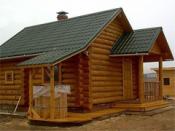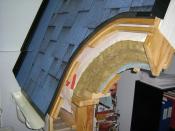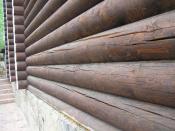Search
Login
Recommended
We remove the stretch ceiling, how to do it correctly and not break it. Basic rules and tricks
There are times when it becomes necessary to dismantle some type of stretch ceiling. This may be due to the need to repair communications hidden under the ceiling, repairing the premises, etc., in such cases, the question arises: is it possible to remove the stretch sheath, will it be necessary to completely dismantle it or partially.
Content
- Remove the stretch ceiling and break - different concepts
- Types and types of ceiling plinth, the beginning of dismantling video
- Features of dismantling a stretch vinyl ceiling
- How to remove the stretch ceiling yourself
- Edge search during dismantling
- Remove the stretch ceiling video
Remove the stretch ceiling and break - different concepts

It must be understood that if it is necessary to completely redesign the ceiling, this is one point, and if you need to make repairs after which it is planned to continue the operation of the ceiling, then this is another, more difficult moment. Let's look at several options for dismantling various types of ceilings.
Dismantling a ceiling made of fabric yourself. First, for this procedure you will need the following:
- pliers
- putty knife
- ladder
- staple remover
- paint knife.
Collected all the tools - you can start work. In this embodiment, a stretch ceiling made of fabric is stretched and attached to the wall by anchors on wooden blocks. But before you start dismantling them you will need to remove the baguette.
It should be noted that during normal dismantling, not the entire ceiling is disassembled, but only certain parts of it. If a complete dismantling is planned, then there is no need to stand on ceremony and be careful.
All the work of dismantling the ceiling consists of the following steps:
- firstly, a certain necessary part of the ceiling is dismantled
- secondly, based on the fact that the ceiling is stretched on four sides - it will be enough to remove the mount from two
- thirdly, exempted parties should be located in the part to which access is needed.
Types and types of skirting boards for the ceiling, the beginning of dismantling

Dismantling the baguette begins with a narrow wall. With a paint knife, the presence of which was specified above, it is necessary to evenly and thinly make a cut along the seam in the place where the baguette is attached to the wall. Usually it is glued to the wall, and not to stretch ceilings.
There are several types of baguettes:
- aluminum
- wooden
- polyester
- foam PVC.
In the event that the skirting board for the ceiling, that is, the baguette, is made of foam, then it will be very difficult to dismantle it carefully. Even a relatively whole baguette made of polystyrene is practically not suitable for subsequent installation. His price is not high, and this makes it possible to buy a new one without any problems.
All work related to the dismantling of the ceiling plinth consists in the following steps:
- after making a thin and even cut, using a spatula, remove baguettes
- to remove it completely, you can insert the staple into the cut and draw it along the seam
- staples can be easily removed with an anti-stapler, if it does not work out, you can use pliers.
Extra care must be taken when separating tissue.
The next stage of dismantling is the separation of the fabric. This stage of the process can be called the most important. The main issue is glue, which was used during installation. In any case, it will be necessary to resort to the help of a spatula and knife. If you act carefully enough, the fabric separated from the wooden bars will remain intact.

The hardest part of the tissue separation process is to successfully separate the first 100 mm. Then the process will go much faster and easier.
The separation process will look something like this: pulling the fabric down with one hand and using a spatula with the other hand, carefully disconnect the cured adhesive. Detachment of glue should take place from a bar made of wood, since the remnants of glue on the fabric during subsequent installation will not interfere with gluing.
Features of dismantling a stretch vinyl ceiling

What needs to be done if it is necessary to dismantle a stretch vinyl ceiling? When dismantling such ceilings, sometimes you just need to drain the water shared by your neighbors from above. In such cases, a completely different technology is used.
To fix this problem, you need the following:
- pliers
- putty knife
- heat gun
Initially, you need to know that dismantling such a ceiling is not an easy task. Of course, if the question is about complete dismantling, then this work is quite simple. And if there is a question of partial dismantling with the subsequent use of this material, then you will have to work hard.

To do this work, you will need certain skills, maximum accuracy, patience and attentiveness. One moment that when installing and disassembling the ceiling it is necessary to use a heat gun, it means a lot. Undoubtedly, not everyone in the tool box has such a device.

It should be noted that when dismantling it will be necessary to increase the temperature in the room, this can be done using a heater. And in order to heat a particular dismantled area, you can resort to using a device such as a hand-held industrial hairdryer. In principle, nothing is feasible.
Remember that dismantling a suspended ceiling without flaws is much more difficult to do than installing it.
How to remove the stretch ceiling yourself
First you need to pay attention to the perimeter of the room, in places of contact with the wall, a special decorative insert with which it will all begin. There will be a seam in this insert. Using a stepladder it will not be difficult to find. Usually, the junction is in the corners of the room. When dismantling, do not resort to sharp objects. They can severely damage the removable ceiling. With the removal of the insert should not be any problems, it is removed quite simply. The next step is to warm the air in the room well.

Masters advise - if it is impossible to maintain the temperature in the range from +40 to +50 degrees, then it is better to refuse dismantling. At lower temperatures, irreparable deformation of the ceiling coating is inevitable.
Edge search during dismantling
As described above, the canvas is drawn using pliers. But remember that before you start working with pliers, you need to prepare them. Preparation consists in the fact that before use all sharp corners need to be grinded, that is, to make them smooth and rounded. After grinding, do the sanding treatment, which eliminates the burrs.
After preparing the tool, carefully inspect the entire perimeter of the room. The task of the inspection is to find a place in which there are protruding edges. It will be for them that it will be possible to take with pliers.
Remove the stretch ceiling

Immediately before the start of removal, you need to heat the place of the ceiling from which you will start. Then you need to take the edge with the pliers for the protruding part and slowly and accurately pull. With such not cunning and careful movements, the ceiling is dismantled. The main thing is not to rush, so as not to spoil the coating. Periodically heat up exactly where you remove the coating. In parallel with this, we must not forget to maintain the desired temperature in the whole room.
Such work will not tolerate haste and turmoil. Adhering to all the above tips and performing all of the above actions correctly, you will get the desired result.

In this article we will not open in detail the topic of how to disconnect harpoons if necessary. It all depends on the type of harpoon and the method of its fastening. In this article, the most basic is revealed - how can all the same remove the ceiling coating without damage.





